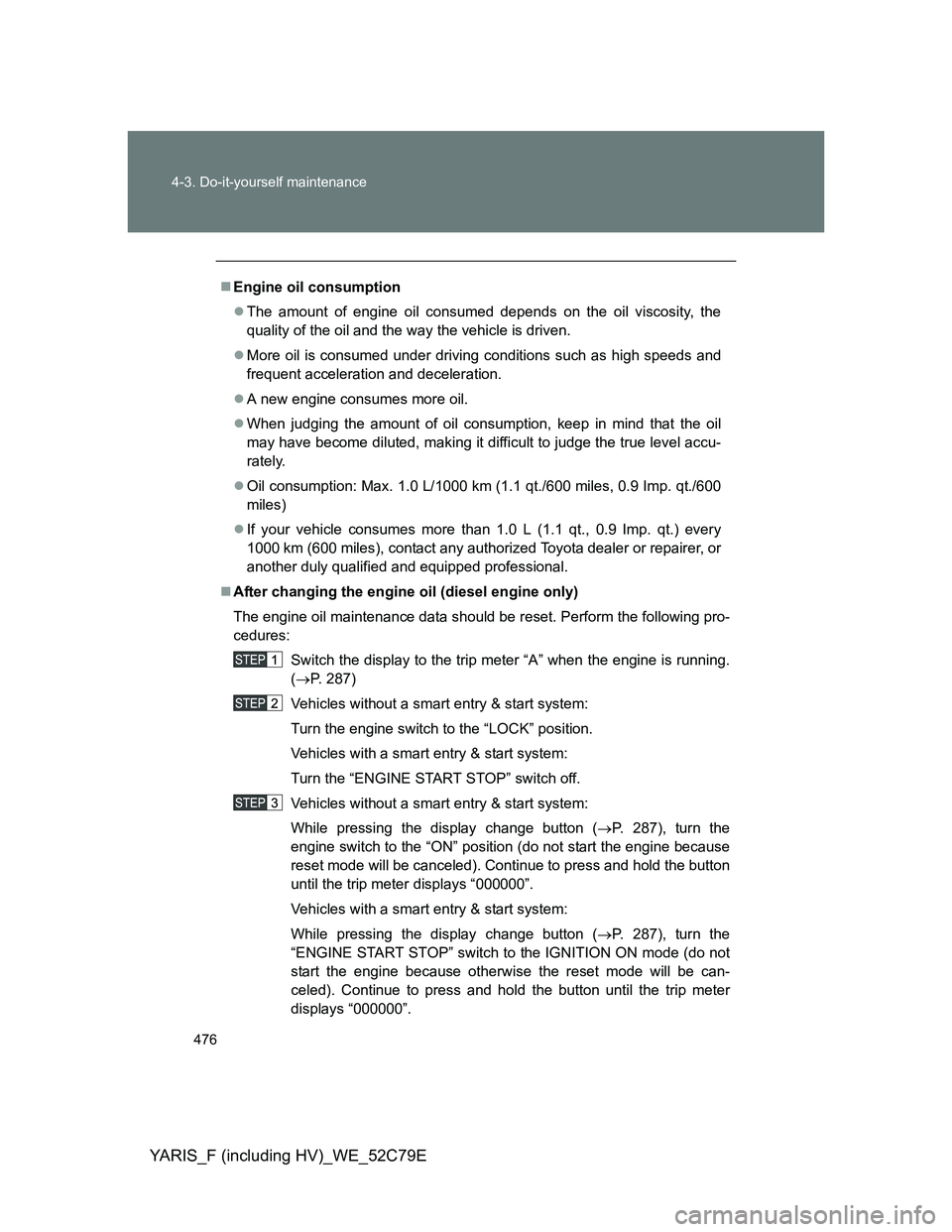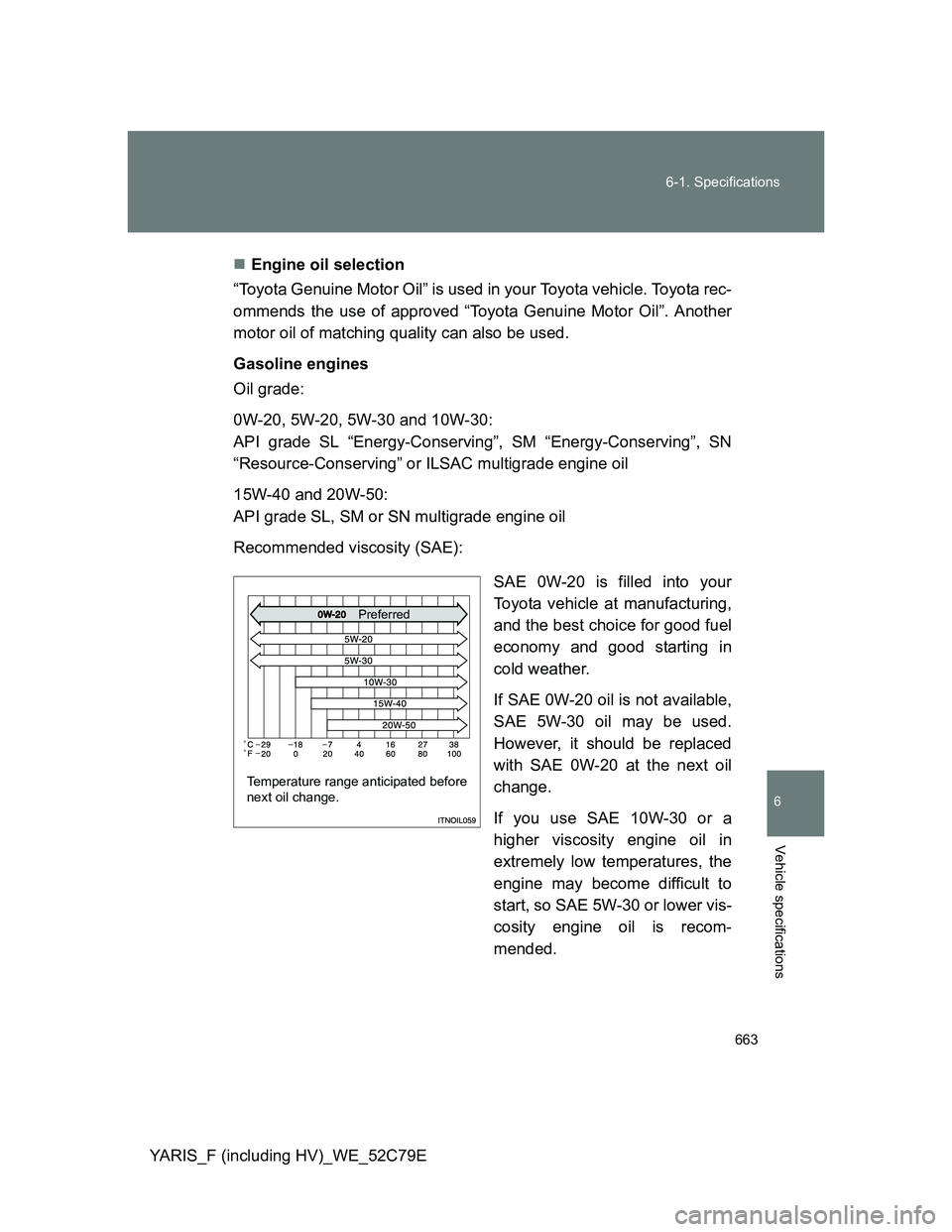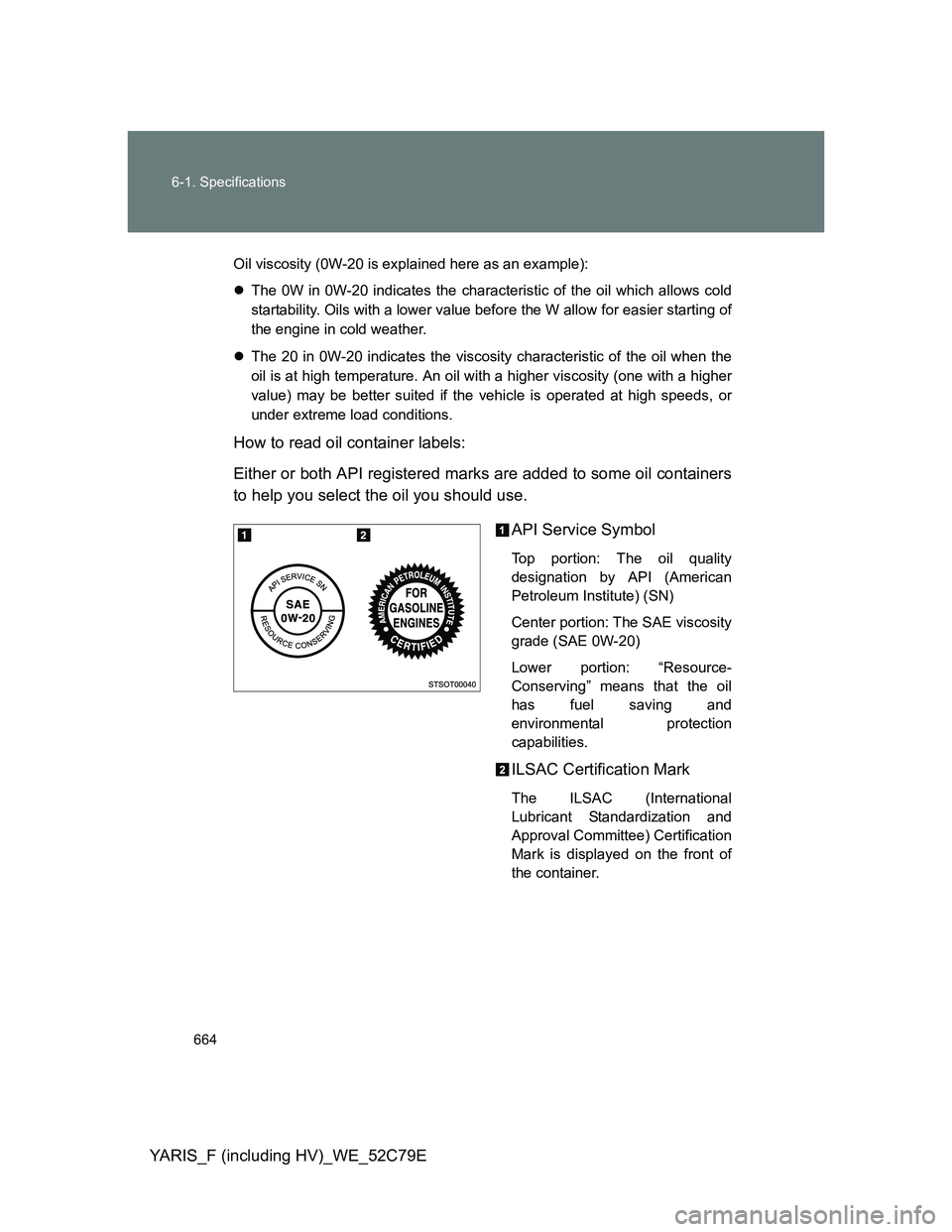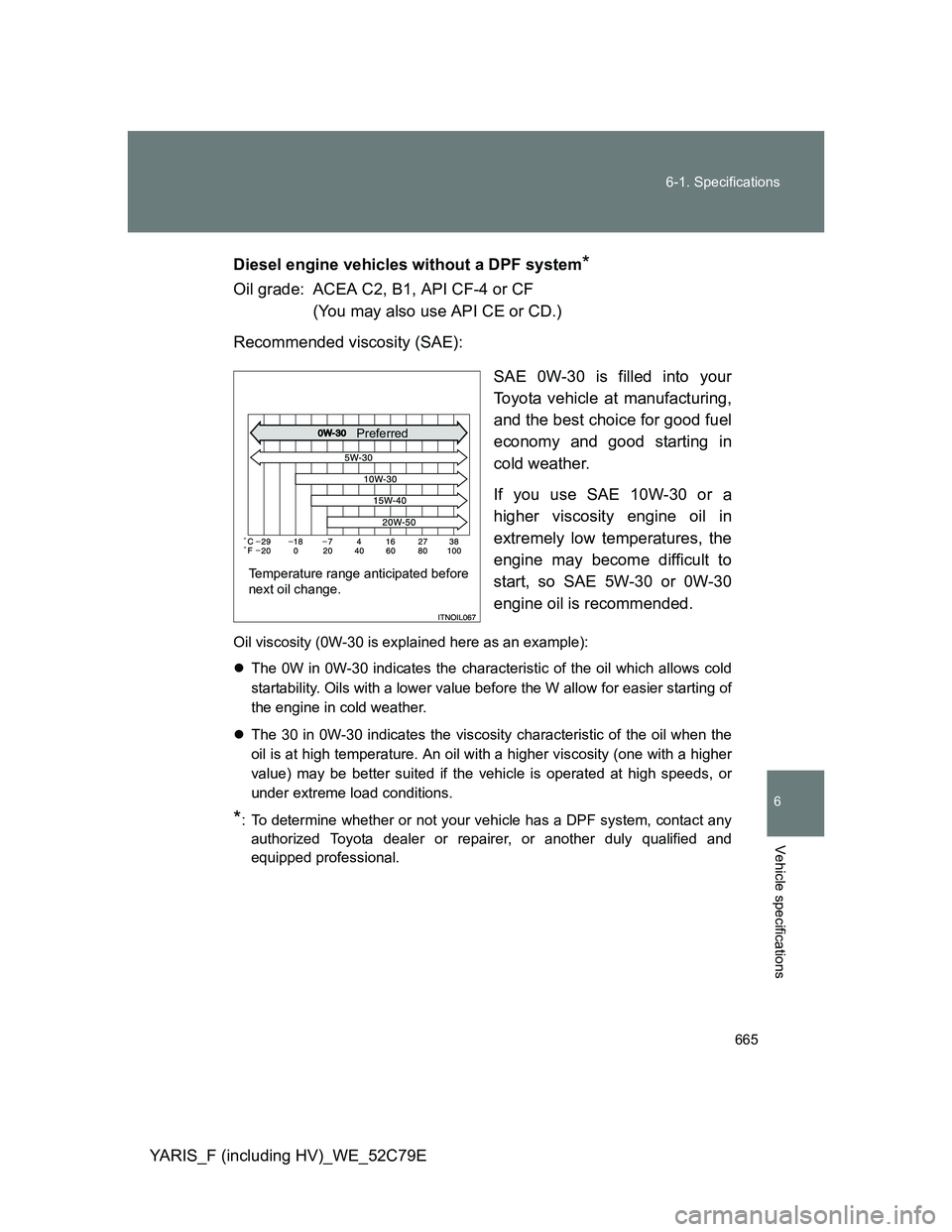Page 476 of 704

476 4-3. Do-it-yourself maintenance
YARIS_F (including HV)_WE_52C79E
Engine oil consumption
The amount of engine oil consumed depends on the oil viscosity, the
quality of the oil and the way the vehicle is driven.
More oil is consumed under driving conditions such as high speeds and
frequent acceleration and deceleration.
A new engine consumes more oil.
When judging the amount of oil consumption, keep in mind that the oil
may have become diluted, making it difficult to judge the true level accu-
rately.
Oil consumption: Max. 1.0 L/1000 km (1.1 qt./600 miles, 0.9 Imp. qt./600
miles)
If your vehicle consumes more than 1.0 L (1.1 qt., 0.9 Imp. qt.) every
1000 km (600 miles), contact any authorized Toyota dealer or repairer, or
another duly qualified and equipped professional.
After changing the engine oil (diesel engine only)
The engine oil maintenance data should be reset. Perform the following pro-
cedures:
Switch the display to the trip meter “A” when the engine is running.
(P. 287)
Vehicles without a smart entry & start system:
Turn the engine switch to the “LOCK” position.
Vehicles with a smart entry & start system:
Turn the “ENGINE START STOP” switch off.
Vehicles without a smart entry & start system:
While pressing the display change button (P. 287), turn the
engine switch to the “ON” position (do not start the engine because
reset mode will be canceled). Continue to press and hold the button
until the trip meter displays “000000”.
Vehicles with a smart entry & start system:
While pressing the display change button (P. 287), turn the
“ENGINE START STOP” switch to the IGNITION ON mode (do not
start the engine because otherwise the reset mode will be can-
celed). Continue to press and hold the button until the trip meter
displays “000000”.
Page 663 of 704

663 6-1. Specifications
6
Vehicle specifications
YARIS_F (including HV)_WE_52C79EEngine oil selection
“Toyota Genuine Motor Oil” is used in your Toyota vehicle. Toyota rec-
ommends the use of approved “Toyota Genuine Motor Oil”. Another
motor oil of matching quality can also be used.
Gasoline engines
Oil grade:
0W-20, 5W-20, 5W-30 and 10W-30:
API grade SL “Energy-Conserving”, SM “Energy-Conserving”, SN
“Resource-Conserving” or ILSAC multigrade engine oil
15W-40 and 20W-50:
API grade SL, SM or SN multigrade engine oil
Recommended viscosity (SAE):
SAE 0W-20 is filled into your
Toyota vehicle at manufacturing,
and the best choice for good fuel
economy and good starting in
cold weather.
If SAE 0W-20 oil is not available,
SAE 5W-30 oil may be used.
However, it should be replaced
with SAE 0W-20 at the next oil
change.
If you use SAE 10W-30 or a
higher viscosity engine oil in
extremely low temperatures, the
engine may become difficult to
start, so SAE 5W-30 or lower vis-
cosity engine oil is recom-
mended.
Temperature range anticipated before
next oil change.
Preferred
Page 664 of 704

664 6-1. Specifications
YARIS_F (including HV)_WE_52C79E
Oil viscosity (0W-20 is explained here as an example):
The 0W in 0W-20 indicates the characteristic of the oil which allows cold
startability. Oils with a lower value before the W allow for easier starting of
the engine in cold weather.
The 20 in 0W-20 indicates the viscosity characteristic of the oil when the
oil is at high temperature. An oil with a higher viscosity (one with a higher
value) may be better suited if the vehicle is operated at high speeds, or
under extreme load conditions.
How to read oil container labels:
Either or both API registered marks are added to some oil containers
to help you select the oil you should use.
API Service Symbol
Top portion: The oil quality
designation by API (American
Petroleum Institute) (SN)
Center portion: The SAE viscosity
grade (SAE 0W-20)
Lower portion: “Resource-
Conserving” means that the oil
has fuel saving and
environmental protection
capabilities.
ILSAC Certification Mark
The ILSAC (International
Lubricant Standardization and
Approval Committee) Certification
Mark is displayed on the front of
the container.
Page 665 of 704

665 6-1. Specifications
6
Vehicle specifications
YARIS_F (including HV)_WE_52C79EDiesel engine vehicles without a DPF system
*
Oil grade: ACEA C2, B1, API CF-4 or CF
(You may also use API CE or CD.)
Recommended viscosity (SAE):
SAE 0W-30 is filled into your
Toyota vehicle at manufacturing,
and the best choice for good fuel
economy and good starting in
cold weather.
If you use SAE 10W-30 or a
higher viscosity engine oil in
extremely low temperatures, the
engine may become difficult to
start, so SAE 5W-30 or 0W-30
engine oil is recommended.
Oil viscosity (0W-30 is explained here as an example):
The 0W in 0W-30 indicates the characteristic of the oil which allows cold
startability. Oils with a lower value before the W allow for easier starting of
the engine in cold weather.
The 30 in 0W-30 indicates the viscosity characteristic of the oil when the
oil is at high temperature. An oil with a higher viscosity (one with a higher
value) may be better suited if the vehicle is operated at high speeds, or
under extreme load conditions.
*: To determine whether or not your vehicle has a DPF system, contact any
authorized Toyota dealer or repairer, or another duly qualified and
equipped professional.
Temperature range anticipated before
next oil change.
Preferred
Page 666 of 704

666 6-1. Specifications
YARIS_F (including HV)_WE_52C79EDiesel engine vehicles with a DPF system
*
Oil grade: ACEA C2
Recommended viscosity (SAE):
SAE 0W-30 is filled into your
Toyota vehicle at manufacturing,
and the best choice for good fuel
economy and good starting in
cold weather.
Oil viscosity (0W-30 is explained here as an example):
The 0W in 0W-30 indicates the characteristic of the oil which allows cold
startability. Oils with a lower value before the W allow for easier starting of
the engine in cold weather.
The 30 in 0W-30 indicates the viscosity characteristic of the oil when the
oil is at high temperature. An oil with a higher viscosity (one with a higher
value) may be better suited if the vehicle is operated at high speeds, or
under extreme load conditions.
*: To determine whether or not your vehicle has a DPF system, contact any
authorized Toyota dealer or repairer, or another duly qualified and
equipped professional.
NOTICE
Using engine oil other than ACEA C2 may damage the catalytic converter.
Temperature range anticipated before
next oil change.
Preferred